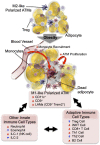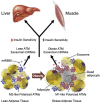Chronic tissue inflammation and metabolic disease
- PMID: 33649162
- PMCID: PMC7919414
- DOI: 10.1101/gad.346312.120
Chronic tissue inflammation and metabolic disease
Abstract
Obesity is the most common cause of insulin resistance, and the current obesity epidemic is driving a parallel rise in the incidence of T2DM. It is now widely recognized that chronic, subacute tissue inflammation is a major etiologic component of the pathogenesis of insulin resistance and metabolic dysfunction in obesity. Here, we summarize recent advances in our understanding of immunometabolism. We discuss the characteristics of chronic inflammation in the major metabolic tissues and how obesity triggers these events, including a focus on the role of adipose tissue hypoxia and macrophage-derived exosomes. Last, we also review current and potential new therapeutic strategies based on immunomodulation.
Keywords: glucose intolerance; immunometabolism; inflammation; insulin resistance; macrophage; metaflammation; β-cell dysfunction.
© 2021 Lee and Olefsky; Published by Cold Spring Harbor Laboratory Press.
Figures




Similar articles
-
Adipose tissue inflammation and metabolic dysfunction: a clinical perspective.Horm Mol Biol Clin Investig. 2013 Sep;15(1):19-24. doi: 10.1515/hmbci-2013-0032. Horm Mol Biol Clin Investig. 2013. PMID: 25436729 Free PMC article. Review.
-
The cellular and signaling networks linking the immune system and metabolism in disease.Nat Med. 2012 Mar 6;18(3):363-74. doi: 10.1038/nm.2627. Nat Med. 2012. PMID: 22395709 Review.
-
Adipose tissue dysfunction contributes to obesity related metabolic diseases.Best Pract Res Clin Endocrinol Metab. 2013 Apr;27(2):163-77. doi: 10.1016/j.beem.2013.02.005. Epub 2013 Mar 6. Best Pract Res Clin Endocrinol Metab. 2013. PMID: 23731879 Review.
-
Inflammatory mechanisms in obesity.Annu Rev Immunol. 2011;29:415-45. doi: 10.1146/annurev-immunol-031210-101322. Annu Rev Immunol. 2011. PMID: 21219177 Review.
-
Molecular basis of ageing in chronic metabolic diseases.J Endocrinol Invest. 2020 Oct;43(10):1373-1389. doi: 10.1007/s40618-020-01255-z. Epub 2020 May 1. J Endocrinol Invest. 2020. PMID: 32358737 Free PMC article. Review.
Cited by
-
Obesity-induced inflammation: connecting the periphery to the brain.Nat Metab. 2024 Jul;6(7):1237-1252. doi: 10.1038/s42255-024-01079-8. Epub 2024 Jul 12. Nat Metab. 2024. PMID: 38997442 Review.
-
The neutral amino acid transporter SLC7A10 in adipose tissue, obesity and insulin resistance.Front Cell Dev Biol. 2022 Sep 12;10:974338. doi: 10.3389/fcell.2022.974338. eCollection 2022. Front Cell Dev Biol. 2022. PMID: 36172277 Free PMC article. Review.
-
Obesity- and lipid-related indices as a predictor of type 2 diabetes in a national cohort study.Front Endocrinol (Lausanne). 2024 Jan 31;14:1331739. doi: 10.3389/fendo.2023.1331739. eCollection 2023. Front Endocrinol (Lausanne). 2024. PMID: 38356678 Free PMC article.
-
Gut Microbial-Derived Short Chain Fatty Acids: Impact on Adipose Tissue Physiology.Nutrients. 2023 Jan 5;15(2):272. doi: 10.3390/nu15020272. Nutrients. 2023. PMID: 36678142 Free PMC article. Review.
-
Management of Obesity-Related Inflammatory and Cardiovascular Diseases by Medicinal Plants: From Traditional Uses to Therapeutic Targets.Biomedicines. 2023 Aug 5;11(8):2204. doi: 10.3390/biomedicines11082204. Biomedicines. 2023. PMID: 37626701 Free PMC article. Review.
References
-
- Amar J, Chabo C, Waget A, Klopp P, Vachoux C, Bermúdez-Humarán LG, Smirnova N, Bergá M, Sulpice T, Lahtinen S, et al. 2011. Intestinal mucosal adherence and translocation of commensal bacteria at the early onset of type 2 diabetes: molecular mechanisms and probiotic treatment. EMBO Mol Med 3: 559–572. 10.1002/emmm.201100159 - DOI - PMC - PubMed
Publication types
MeSH terms
Grants and funding
LinkOut - more resources
Full Text Sources
Other Literature Sources
Medical
